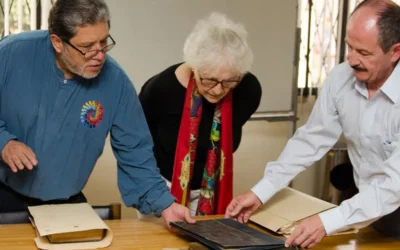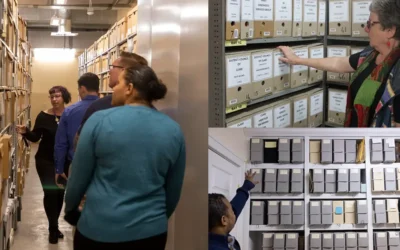Reference for Archives
Margot Note
Reference and access, two important areas of public services, are tied to all the activities that archivists perform.
Archivists prepare materials for use according to archival theory and practice; they treat materials like aggregates, arrange and describe them, and make finding aids. Archivists provide initial access through these surrogates, rather than sending researchers to the stacks to browse through the collections. Instead, archivists search within the descriptive tools themselves.
Archivists have a dual responsibility. They both collect and preserve historic resources. A professional conflict for archivists is how to strike a balance between the two. As always, with all archival matters, the level of reference depends on resources, audiences, and other factors.
Defining Reference
Reference refers to the activities by which archivists bring the users and primary sources together. These activities include aiding in person, by mail, telephone, fax, email, or virtually. Reference services may be offered through public programs both within and outside of the repository or offered by lone arrangers, reference departments in larger repositories, or in some repositories, by subject specialists. Professional and paraprofessional staff may perform reference duties. Another option combines locating materials and helping researchers use them, which implies that the archivist is familiar with the subjects in the collections and knows how to perform research within them.
The Reference Interview
The reference interview at an archival repository usually has three stages. The first is query abstraction, where the archivist and researcher translate the query into a series of topics. The next is resolution, where they both relate the subject to records. Lastly, refinement is the state where the researcher refines the queries and topics, adds the names of organizations, people, and events that they discovered, and then repeats the process. Unlike reference interviews in libraries, reference questions in an archives are more likely to result in a search strategy than a specific answer.
Archival Users
A repository’s audiences are, as always, an essential factor for reference services. Archivists distinguish between internal and outside users, as well as their expertise. For example, genealogists, fellow employees, scholars, and high school students embody different skills and expectations.
Archivists need to understand their current audiences—not just their satisfaction, but their information-seeking behavior, which includes how they approach the materials and how they use the finding aids. Archivists must also think about potential audiences and whom they would like to attract.
Users may be direct or indirect. Direct users are those who obtain information from the repository, such as someone who calls or writes. Direct use, for example, could be administrative use of institutional archives or research use from outside. Indirect users are people who benefit from the archival holdings without ever actually coming into a repository, because a movie, exhibition, legal brief, genealogy, or other activities transmitted primary source information. Think how many people have benefited from a documentary or podcast that used archival materials in their storytelling. The proliferation of content on the web complicates matters. How does one categorize researchers who have used materials digitally, but have never visited the archives?
Archivists make several assumptions about researchers concerning reference. They assume users have done preliminary research before coming to the archives. They also expect that they will be able to link names and subjects since it’s easier to provide access to the former than the latter. They hope that researchers are willing to review aggregate collections since item-level access is so rare. As archivists, we must educate our patrons, especially novice users, on how to use archival holdings and make them feel comfortable.
At Your Service
Archives exist to serve researchers. An archival repository can have state-of-the-art facilities, brilliantly processed collections, and knowledgeable staff. If the archival collections aren’t being used—by a variety of researchers working on an array of projects—all that strategy and talent is for naught. Reference is the process of connecting users to the primary sources that can answer their research questions.
Margot Note
Margot Note, archivist, consultant, and author is a guest blogger for Lucidea, provider of ArchivEra, archival collections management software for today’s challenges and tomorrow’s opportunities. Read more of Margot’s posts here, and get your free copy of Margot’s book under the Lucidea Press imprint, Demystifying Archival Project Management: Five Essentials for Success
Similar Posts
Navigating Selection in Archival Practice
The archival selection process is far from straightforward, given the limitations of long-term preservation and ongoing accessibility challenges.
Responsible Stewardship in Archival Practice
Responsible stewardship is a philosophy that guides the actions and decisions of archivists in safeguarding collective memory.
A Modern View of a City’s History via ArchivEra
Brief success story on City of Regina Archives’ use of ArchivEra to manage collections of legal, historical, administrative or financial significance
Stewards of the Past, Guardians of the Future
Archival preservation bridges the past and future, allowing the voices and stories of bygone eras to resonate with contemporary and future audiences.
Hosting service
Enjoy all of the benefits of your Lucidea solution with secure, reliable, stress free hosting
Programs & incentives
No matter your size or budget, we’ve got you covered, today and tomorrow




Leave a Comment
Comments are reviewed and must adhere to our comments policy.
0 Comments